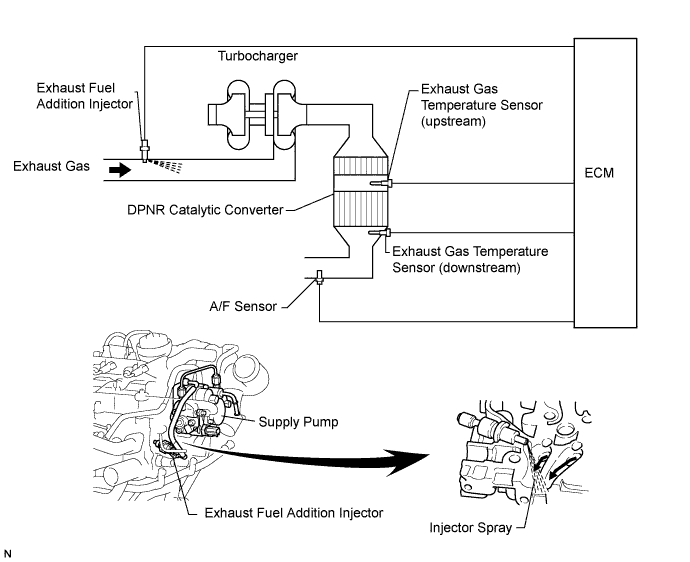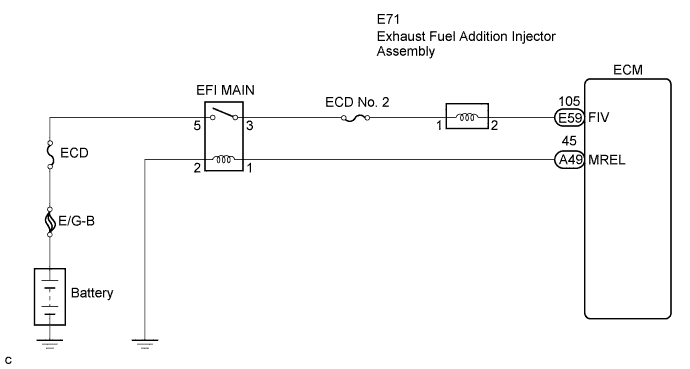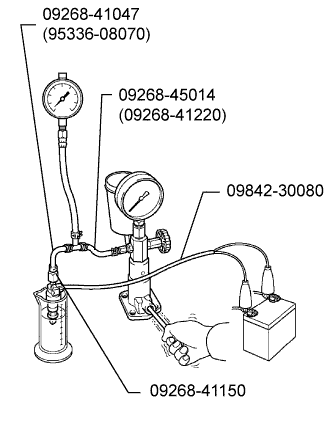Lexus IS250 IS220d GSE20 ALE20 2AD-FHV ENGINE CONTROL SYSTEM
CHECK OTHER DTC OUTPUT (IN ADDITION TO DTC P1386)
READ VALUE OF INTELLIGENT TESTER (EXHAUST GAS TEMPERATURE)
CHECK EXHAUST GAS (WHITE SMOKE AND FUEL SMELL)
READ VALUE OF INTELLIGENT TESTER (DPNR A/F)
READ VALUE OF INTELLIGENT TESTER (EXHAUST GAS TEMPERATURE)
READ VALUE OF INTELLIGENT TESTER (A/F RATIO)
INSPECT EXHAUST FUEL ADDITION INJECTOR ASSEMBLY
CHECK HARNESS AND CONNECTOR (EXHAUST FUEL ADDITION INJECTOR - ECM)
CHECK FOR FUEL LEAKAGE (IN EXHAUST FUEL ADDITION INJECTOR)
READ VALUE OF INTELLIGENT TESTER (COMPENSATION OF INJECTION VOLUME)
INSPECT EXHAUST FUEL ADDITION INJECTOR (INJECTION VOLUME)
PERFORM ACTIVE TEST BY INTELLIGENT TESTER (DPNR CATALYST REGENERATION)
REPLACE EXHAUST FUEL ADDITION INJECTOR ASSEMBLY
PERFORM ACTIVE TEST BY INTELLIGENT TESTER (DPNR CATALYST REGENERATION)
INSPECT EXHAUST FUEL ADDITION INJECTOR (INJECTION VOLUME)
DTC P1386 Injector for Exhaust Fuel Addition
DESCRIPTION

The exhaust fuel addition injector is mounted on the exhaust port of the cylinder head, and low pressure is provided to the injector by the feed pump in the supply pump. This injector adds fuel by a control signal from the ECM.
This injector is used for two different controls: DPNR catalyst regeneration and nitrogen oxides (NOx) reduction.
Under the DPNR catalyst regeneration control, the injector adds fuel to raise a catalyst temperature.
In the other control, the injector helps the air-fuel ratio become RICH. As a result, NOx in the exhaust gas will be reduced in response to the RICH air-fuel ratio.
- HINT:
- *1: Diesel Clean Advanced Technology
- *2: Diesel Particulate-NOx Reduction system
| DTC No. | DTC Detection Condition | Main Trouble Area | Related Trouble Area |
| P1386 | Excess or low fuel addition volume from exhaust fuel addition injector: Air-fuel ratio deviates from a value estimated by ECM while the injector is adding fuel (1 trip detection logic) | Open or short in exhaust fuel addition injector circuit Exhaust fuel addition injector DPNR catalytic converter (Manifold converter sub-assembly) | Open in exhaust temperature sensor circuit A/F sensor Exhaust gas temperature sensor Supply pump assembly Mass air flow meter Fuel leaks in exhaust fuel addition injector Main injector Cylinder compression pressure Valve clearance Valve timing Blockage in air intake system Leakage in air intake system Blockage in exhaust system Leakage in exhaust system Blockage in EGR system Leakage in EGR system ECM |
| Low fuel addition volume from exhaust fuel addition injector: Learning value (*3) exceeds standard level (1 trip detection logic) | |||
| Exhaust fuel addition injector nozzle stuck open: Air-fuel ratio becomes RICHER than standard level, or exhaust gas temperature becomes higher than standard level (1 trip detection logic) |
*3: Correction learning value of the fuel addition volume to raise the DPNR catalyst temperature to a target range.
- HINT:
MONITOR DESCRIPTION
- HINT:
- "Learning value" used here represents a correction learning value of the fuel addition volume to raise the DPNR (*4) catalyst temperature to a target range.
- *4: Diesel Particulate-NOx Reduction system.
In order to detect malfunctions in the exhaust fuel addition injector, the ECM monitors the air-fuel ratio, DPNR catalytic temperature and learning value.
| Fail-Safe Operation | Malfunction Condition | Malfunction Detection Condition | Drive Pattern |
| No fail-safe operation | Low or excess fuel addition volume from the exhaust fuel addition injector | Actual air-fuel ratio deviates from a value estimated by the ECM when the exhaust fuel addition injector adds fuel during NOx reduction | After warming up the engine, perform DPNR REJU (PM) in the ACTIVE TEST menu using the intelligent tester, and drive at constant vehicle speed within 50 to 100 km/h (31 to 62 mph) for more than 15 minutes |
| Limits engine power by permitting driving at a maximum vehicle speed of approximately 80 km/h (50 mph) | Exhaust fuel addition injector has stuck open | DPNR catalytic converter temperature becomes higher than 800°C (1,472°F) or air-fuel ratio is less than approximately 12.0 : 1 for a couple of seconds | Idling engine for more than 5 minutes (*5) |
Limits engine power by permitting driving at a maximum vehicle speed of approximately 80 km/h (50 mph)
| Low fuel addition volume from the exhaust fuel addition injector | During DPNR catalyst regeneration, when learning value of 1.99 or more continues for a certain period of time (*6) | After warming up the engine, perform DPNR REJU (PM) in the ACTIVE TEST menu using the intelligent tester, and drive at constant vehicle speed within 50 to 100 km/h (31 to 62 mph) for more than 30 minutes |
*5: The DPNR catalytic converter temperature will not reach 800°C (1,472°F) or higher while idling the engine even if the exhaust fuel addition injector has stuck open.
*6: While the DPNR catalyst regeneration is performed, the ECM raises the DPNR catalytic converter temperature to more than 600°C (1,112°F) by adding fuel using the exhaust fuel addition injector. If the temperature does not reach 600°C (1,112°F) during the attempt, the correction learning value of the fuel addition volume increases by increments in order to raise the DPNR catalytic converter temperature to the target range.

WIRING DIAGRAM

INSPECTION PROCEDURE
- HINT:
- "Learning value" used in here represents a correction learning value of the fuel addition volume to raise the DPNR catalyst temperature to a target range.
| 1.CHECK OTHER DTC OUTPUT (IN ADDITION TO DTC P1386) |
Connect the intelligent tester to the DLC3.
Turn the engine switch ON (IG) and turn the intelligent tester ON.
Enter the following menus: "Powertrain / Engine / DTC".
Read DTCs.
- Result:
Display (DTC output) Proceed to P1386 A P1386 and other DTCs B
- HINT:
- If codes other than P1386 are output, perform troubleshooting for those DTCs first.
|
| ||||
| A | |
| 3.READ VALUE OF INTELLIGENT TESTER (EXHAUST GAS TEMPERATURE) |
Connect the intelligent tester to the DLC3.
Turn the engine switch ON (IG) and turn the intelligent tester ON. (Do not start the engine.)
Enter the following menus: Powertrain / Engine / Data List / Initial Exhaust Temp (In) and Initial Exhaust Temp (Out) and read its value displayed on the intelligent tester.
- Result:
Temperature Displayed Proceed to OK (Same value as actual exhaust gas temperature) A 1,000°C (1,832°F) B
- HINT:
- If there is an open circuit, the intelligent tester indicates 1,000°C (1,832°F).
|
| ||||
| B | |
| 5.READ VALUE OF INTELLIGENT TESTER (DPNR A/F) |
- CAUTION:
- Stop the engine immediately if there is white smoke or a fuel smell during the following inspection. Fuel may be leaking from the exhaust fuel addition injector.
Connect the intelligent tester to the DLC3.
Turn the engine switch ON (IG) and turn the intelligent tester ON.
Start the engine.
Enter the following menus: Powertrain / Engine / Data List / DPNR A/F.
Read the air-fuel ratio displayed on the tester after idling the engine for 3 minutes.
- Result:
A/F Ratio Proceed to More than 12 A Less than 12 B
|
| ||||
| A | |
| 6.READ VALUE OF INTELLIGENT TESTER (EXHAUST GAS TEMPERATURE) |
- CAUTION:
- Stop the engine immediately if there is white smoke or a fuel smell during the following inspection. Fuel may be leaking from the exhaust fuel addition injector.
Connect the intelligent tester to the DLC3.
Turn the engine switch ON (IG) and turn the intelligent tester ON.
Start the engine.
Enter the following menus: Powertrain / Engine / Data List / Initial Exhaust Temp (In) and Initial Exhaust Temp (Out).
Check that exhaust gas temperature is within the specification below.
- Result:
Condition Exhaust Gas Temperature Idling after warming up engine Constant at approximately 50 to 700°C (122 to 1,292°F)
|
| ||||
| A | |
| 12.CHECK ENGINE CONTROL SYSTEM |
Check that there is no abnormality in the main injector, cylinder compression pressure, valve timing, and valve clearance.
Check that there is no leakage or blockage in the air intake, exhaust, and EGR systems.
|
| ||||
| OK | |
| 13.INSPECT EXHAUST FUEL ADDITION INJECTOR (INJECTION VOLUME) |

Remove the exhaust fuel addition injector.
Attach the exhaust fuel addition injector to a nozzle tester.
- SST
- 09268-41047(95336-08070)
09268-45014(09268-41220)
09268-41150
Apply a pressure of 0.29 MPa (3.0 kgf/cm2, 42 psi) to the nozzle tester.
Connect SST (wire) to the exhaust fuel addition injector.
- SST
- 09842-30080
Inspect the injector.
- Standard:
Condition Result Leave the injector undisturbed for 1 minute with fuel pressurized No leakage from the injector Apply battery voltage to the injector Fuel is emitted from the injector
- HINT:
- Reference:
- 25 cm3 (1.5 cu.in.)
Reinstall the exhaust fuel addition injector.
|
| ||||
| OK | |
| 14.PERFORM ACTIVE TEST BY INTELLIGENT TESTER (DPNR CATALYST REGENERATION) |
Clear the learning value by removing the negative battery cable for more than 1 minute.
Connect the intelligent tester to the DLC3.
Turn the engine switch ON (IG) and turn the intelligent tester ON.
Enter the following menus: Powertrain / Engine / Active Test / Activate the DPNR Rejuvenate (PM).
After warming up the engine, drive the vehicle at a constant speed within 50 to 100 km/h (31 to 62 mph) (with smooth throttle operations) for more than 15 minutes.
Enter the following menus: Powertrain / Engine / Data List / AFS FT B1 S1, Initial Exhaust Temp (In), Initial Exhaust Temp (Out) and Exhaust Fuel Addition FB.
Check the exhaust gas temperatures (Initial Exhaust Temp (In) and (Out)) and the learning value (Exhaust Fuel Addition FB).
- Result:
Result Proceed to Exhaust gas temperature does not become higher than 600°C (1,112°F) A Exhaust gas temperature becomes higher than 600°C (1,112°F), and the learning value remains in the vicinity of 1.0 B
|
| ||||
| A | |
| 15.REPLACE EXHAUST FUEL ADDITION INJECTOR ASSEMBLY |
| NEXT | |
| 16.PERFORM ACTIVE TEST BY INTELLIGENT TESTER (DPNR CATALYST REGENERATION) |
Clear the learning value by removing the negative battery cable for more than 1 minute.
Connect the intelligent tester to the DLC3.
Turn the engine switch ON (IG) and turn the intelligent tester ON.
Enter the following menus: Powertrain / Engine / Active Test / Activate the DPNR Rejuvenate (PM).
After warming up the engine, drive the vehicle at a constant speed within 50 to 100 km/h (31 to 62 mph) (with smooth throttle operations) for more than 15 minutes.
Enter the following menus: Powertrain / Engine / Data List / AFS FT B1 S1, Initial Exhaust Temp (In), Initial Exhaust Temp (Out) and Exhaust Fuel Addition FB.
Check the exhaust gas temperatures (Initial Exhaust Temp (In) and (Out)) and the learning value (Exhaust Fuel Addition FB).
- Result:
Result Proceed to Exhaust gas temperature does not become higher than 600°C (1,112°F) A Exhaust gas temperature becomes higher than 600°C (1,112°F), and the learning value remains in the vicinity of 1.0 B
|
| ||||
| A | ||
| ||
| 17.INSPECT EXHAUST FUEL ADDITION INJECTOR (INJECTION VOLUME) |

Remove the exhaust fuel addition injector.
Attach the exhaust fuel addition injector to a nozzle tester.
- SST
- 09268-41047(95336-08070)
09268-45014(09268-41220)
09268-41150
Apply a pressure of 0.29 MPa (3.0 kgf/cm2, 42 psi) to the nozzle tester.
Connect SST (Wire) to the exhaust fuel addition injector.
- SST
- 09842-30080
Inspect the injector.
- Standard:
Condition Result Leave the injector undisturbed for 1 minute with fuel pressurized No leakage from the injector Apply battery voltage to the injector Fuel is emitted from the injector
- HINT:
- Reference:
- 25 cm3 (1.5 cu.in.)
Reinstall the exhaust fuel addition injector.
|
| ||||
| OK | ||
| ||